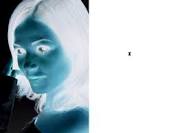Negative Optical Illusion: A negative optical illusion or negative picture illusion occurs when the cone cells in our eyes become fatigued and overstimulated, which results in losing sensitivity.
The image you see resulting from the negative picture illusion is called a negative afterimage.
What is a Negative Image?
A negative image is an inverse of a positive or normal image. In such images, the lighter areas appear dark and darker areas light.
The images captured by the previous cameras were in the form of negatives that had to be developed into positive images in the studio.
Similarly, in negative picture illusion or optical illusion, our vision system, in association with the brain, creates a colour image of a subject from its negative image.
How to Create Negative Optical Illusion
Look at the image below

Now follow these steps as mentioned below:
Step 1: Stare at the dot on the woman’s face presented above for 25-30 seconds
Step 2: Now, immediately shift your focus to the white space
Step 3: Blink quickly and repeatedly for sometime
You will notice a coloured image of the woman for a brief period. The coloured image that you have seen is called a negative afterimage.
Also Read:
Optical Illusion: What You See First Reveals Your Hidden Desires in Love
Negative Optical Illusion - How it Works
A negative photo illusion is created when we experience a negative afterimage. A negative afterimage is created as a result of overstimulation of the photoreceptors and cone cells of the eye, which causes them to lose sensitivity and process the information appropriately.
When you stare at one negative image for a long time, the cone cells, sensitive to the three main colours, red, green and blue, become fatigued depending on which colour is focused on most.
It happens once you divert your vision to look at the white or light background. The receptors adapted to one colour will respond by sending a weak signal.
The surrounding colour receptors send out a strong signal to the brain. As the signal is received from the three colour receptors are not in balance to see colour, our brain processes afterimages which are coloured pictures.
These coloured pictures are made from the pairing of the primary colours.
The Appearance of Negative Afterimages Explained
The appearance of negative afterimages can be explained by the opponent-process theory of vision, which states that two opposing systems that control our perception of colour are the blue-yellow system and the magenta-green system.
According to this theory, our brain can register only one pair of colours among these as the colour sets oppose each other.
When staring too long at a magenta image, you will see a green afterimage.
That was all about the negative optical illusion. For more such informational stories, stay connected with us.
